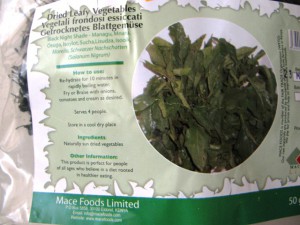- CIFOR has a blog!
- Nice series of videos on eating weeds.
- Video on Peru’s “Andean rodeo.” You heard me.
- Africa needs drought-tolerant maize. Ok, fair enough, but here’s my question. Shouldn’t they have done this study before doing all that breeding? Oh, who knows, maybe they did.
- “Biofortification will thus remain relevant to poor rural populations in the years to come, as their incomes will still be far too low to afford a more diversified diet.” What? Who says a diversified diet need be expensive?
- Russia faces looming buckwheat crisis. At least the genetic resources are safe in the Vavilov Institute. Unless of course somebody decides to, I don’t know, build luxury villas there, or something.
Local leafy greens go viral in Kenya
 I continue to be amazed by the progress being made by — or, better, the resurgence of — indigenous leafy greens in Kenya. You can now buy managu (Solanum scabrum?) nicely packaged in supermarkets. Although it is also sold loose on the street.
I continue to be amazed by the progress being made by — or, better, the resurgence of — indigenous leafy greens in Kenya. You can now buy managu (Solanum scabrum?) nicely packaged in supermarkets. Although it is also sold loose on the street.

And this is what the plant looks like.

 I found it in my sister-in-law’s homegarden in Limuru, along with Amaranthus. She didn’t grow either of them until a couple of years back. Progress. More holiday snaps here.
I found it in my sister-in-law’s homegarden in Limuru, along with Amaranthus. She didn’t grow either of them until a couple of years back. Progress. More holiday snaps here.
Nibbles: Eggplant, Cactus domestication, Berries, Conservation, Drought, Conference, Chaffey, Rice relative, Cornus, Adansonia, Pavlovsk, Genebanks, Dams
- How can you do Eggplant’s Rich History and not wonder why this generally huge, generally purple thing is called an eggplant?
- Domestication of the Gray Ghost Organ Pipe cactus; exceedingly complex. Oh and there’s a cool photo here.
- How berries protect the brain from age-related malfunction. Are you listening, Dmitry?
- Protect medicinal plants, says letter-writer.
- The world doesn’t understand drought tolerance, says another letter-writer.
- Agrobiodiversity in Mesoamerica conference.
- Chaffey’s Plant Cuttings from Annals of Botany. Must-read stuff.
- A wild relative contributes trait for early morning flowering to rice, allowing it to escape sterility induced by high temperatures.
- The Cornelian Cherry and the Baobab explained.
- Voice of America devotes Special English report to Pavlovsk. If that ain’t viral, what is?
- Genebanks on a roll in China. In Australia, not so much.
- Dam dataset online. Let the mashups proliferate.
How would you promote agricultural biodiversity?
Here’s the scenario: the civic authorities have decided to install a home garden somewhere in the centre of the city. This is in a country with a very conservative attitude to its food culture, where tradition runs deep (although not as deep as to recognize that several staples of the cuisine arrived as interlopers from other lands, roughly 500 years ago.) And because your organization is based in that same city, and has a reputation for knowing about agricultural biodiversity and home gardens, the authorities have asked you to contribute in some way.
You don’t exactly know why the civic authorities are constructing the garden, although you suspect it has something to do with being seen to be green, to care about food and about diversity. And you don’t know what they want, either, or what kind of experience they are planning to offer the visiting public. A gawp at vegetables in the ground rather than in plastic? Surely not. The country hasn’t lost its agrarian roots that completely. Edumacashun? Yeah, but what is the message? You also don’t know what they want. Advice? Expertise? Something to give to visitors?
So you decide to offer them plants that might be found in a home garden far away, specifically, the nutritious African leafy vegetables that you’ve been promoting for better health, incomes and environmental sustainability. But you fear that the civic authorities might not be too keen. You fear they are likely to say something like: “Why should we plant your strange African vegetables in a garden here? What’s the point?”
What one, killer argument would you offer to persuade them?
Nibbles: Huitlacoche, Failure, Food sovereignty, Cold storage, Hunger, Prices
- Mat Kinase discover best smut ever.
- World Bank embraces failure. Now there’s an idea. More here.
- I really don’t have time today for Food sovereignty in Africa: The people’s alternative. Anyone care to interpret?
- Kremlin now tweeting in English. No word yet on Pavlovsk.
- Kenya invests in new market facilities … to improve exports of food.
- Rachel Laudan considers hunger — and celebrates David Livingstone.
- Speaking of which, wanna understand food price spikes? Me too.